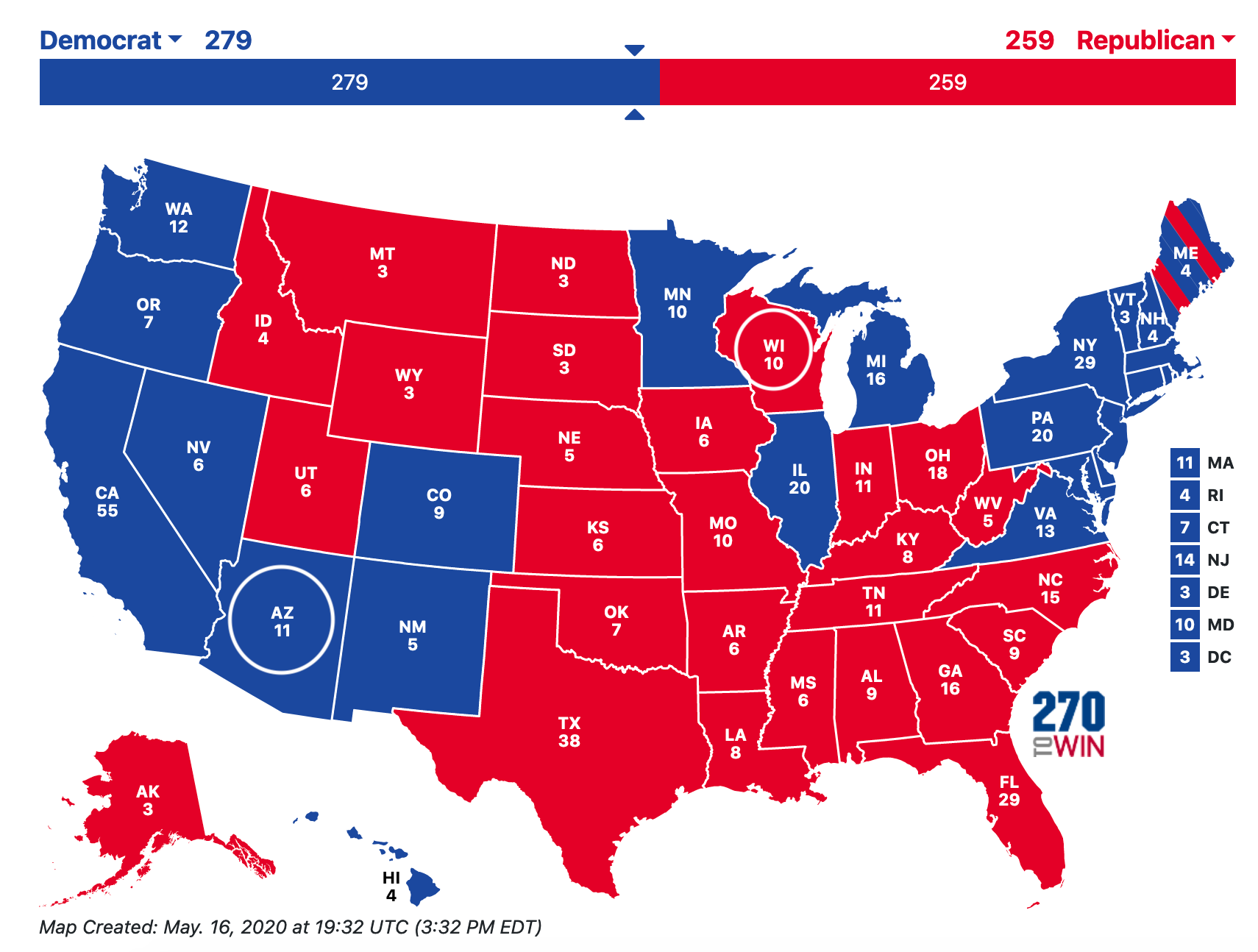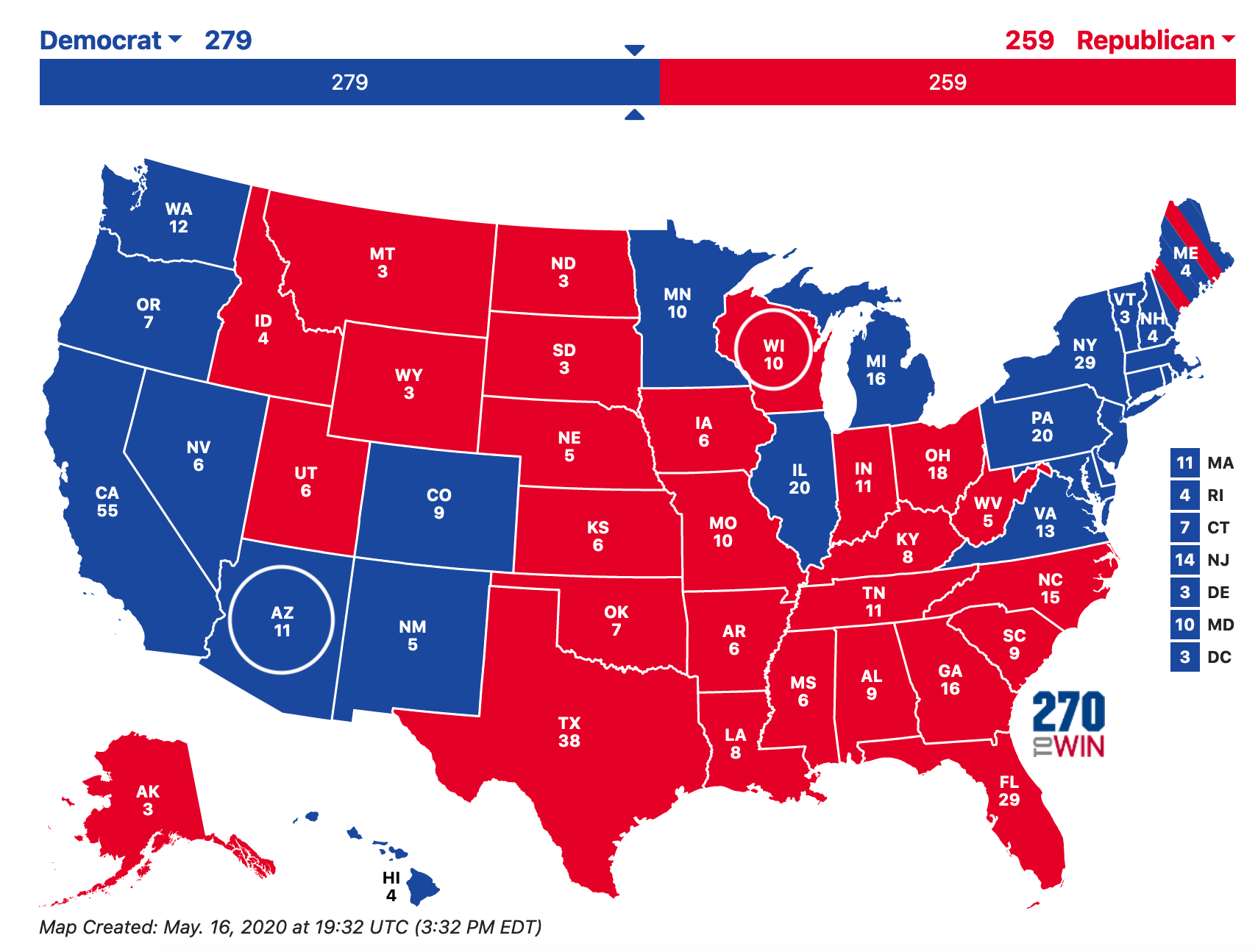The interconnection between the technology business and geopolitics has become increasingly exposed, as the US-China trade war and export control continue to heat up during the coronavirus pandemic. Another less-discussed but equally important layer to this interconnection is how domestic politics and elections dictate the evolution of this link.
Both layers are on full display recently when, within a 24-hour window, the U.S. Department of Commerce toughened its export control on Huawei for national security reasons and the Taiwan Semiconductor Manufacturing Company (TSMC) announced its intention to build an advanced chip foundry in, of all places, Phoenix, Arizona.
There are two maps that we need to overlay on top of this issue to better understand its intricacies: the 2020 electoral map and the Wassenaar Arrangement member nation map.
The Wassenaar Map
Most analysis of the semiconductor industry’s geopolitical impact uses a “US vs China” lens. But it’s broader than that. The more comprehensive one should be “Wassenaar vs China” lens.
According to its own official description, the Wassenaar Arrangement is:
“...the first global multilateral arrangement on export controls for conventional weapons and sensitive dual-use goods and technologies...designed to promote transparency, exchange of views and information and greater responsibility in transfers of conventional arms and dual-use goods and technologies, thus preventing destabilising accumulations.”
In more plain terms, it is a membership organization that coordinates how to control or restrict technology transfer to non-member countries that could be used in hostile ways, aka “destabilising accumulations”. Semiconductor manufacturing technology, what TSMC and other foundries use, would fall under dual-use, because it can be used to make both products used by the military and everyday consumers.
Here’s the Wassenaar Map. The dark-dotted countries are members of the Wassenaar Agreement:

Overlaying this map with where all the chip foundries are, notable places that are *not* part of the agreement are China, Taiwan, and Singapore. Interestingly, Russia is part of the agreement, even though it has become quite adversarial towards the U.S. and much of Europe since Putin began his third presidential term in 2012.
The reason why Taiwan is not part of the agreement could be two-fold:
1. Its nation-state status is uncertain. Depending on who you ask, Taiwan is either a beacon of democracy or a “renegade province”. As China becomes more powerful over the last two decades, the number of countries that use to recognize Taiwan as a country has been decreasing. The Wassenaar Agreement’s participating members are all nation-states -- no NGOs, IGOs, or places of ambiguous status;
2. Taiwan’s relationship with China is volatile and fluctuates quite a bit depending on who is running the place. Its current president, Tsai Ing-wen, is strongly pro-independence and antagonistic towards China. Her predecessor, Ma Ying-jeou, was more pro-status-quo and cooperative towards China. When the Wassenaar Agreement was first formed in 1996, the Taiwanese democracy that we know today was also in its infancy -- holding its very first presidential election that year, while living through the Taiwan Strait Crisis that involved missile tests from China and two American aircraft carriers moving in to stabilize the region. Taiwan was busy trying to survive.
Even though Taiwan is not officially part of the Wassenaar Agreement, it does maintain an export control list that tracks the Agreement’s guideline, and takes its cues from the U.S. Back in 2007, when the Chairman and founding CEO of TSMC, Morris Chang, gave an extensive biographical interview and was asked about whether the Taiwanese government should allow its semiconductor technology to be transferred to China, he smartly skirted around the question and said: “I think the Taiwan government should certainly watch what the U.S. government is doing.”
Chang also mentioned in the same interview that the U.S. was the strictest among all the Wassenaar countries. Given the rise in geopolitical tension during the years since that interview, not only has the U.S. become more strict, it is also applying its influence to restrict other Wassenaar countries from doing business with China. In early 2020, the Trump administration did exactly that with the Dutch government to block the sale of lithography, a dual-use technology, to Semiconductor Manufacturing International Corp (SMIC), the largest Chinese chipmaker. Worth noting that three days after this latest round of restrictions on Huawei, SMIC received a $2.2 billion USD equity investment from the Chinese government.
So Why Arizona?
Not only has TSMC, and Taiwan in general, been caught in the middle of this “Wassenaar vs China” tension, it is now squarely caught in the electoral tension of the upcoming 2020 US presidential contest as well, by choosing to build its new foundry in Arizona.
For those of you who don’t follow American politics closely, Arizona has become a top swing state in the upcoming election. Seasoned political strategists see Biden’s most likely path to victory is winning Arizona, plus Pennsylvania and Michigan, while losing all the other swing states, as illustrated in this map:

I circled both Arizona and Wisconsin (in white) on this map, because Wisconsin is the other swing state that has received a sizable investment from another Taiwanese manufacturer, Foxconn, which has so far produced nothing except empty buildings. However, the Foxconn investment announced in mid-2017 was a potent political talking point for the 2018 midterm election, and it still promises to start production this year despite all the delays, conveniently offering up another round of political talking points.
Some close reading of TSMC’s official announcement of the Arizona foundry shows many similarities. It specified a topline, headline-grabbing investment amount ($12 billion USD), a direct job creation number (1,600), and the boilerplate indirect job creation number of “thousands”. Construction conveniently starts in 2021, after the election, and production is targeted to begin in 2024, conveniently during the next presidential election year. How can the manufacturing of two products as different as semiconductors (TSMC) and LCD panels (Foxconn) both so neatly pack into the American electoral calendar and located in hotly contested swing states?
Meanwhile, the promised 5-nanometer technology and the future 20,000 wafers per month capacity (whenever production is functioning at full speed) is minuscule compared to the more than 1 million per month capacity that TSMC has already reached this year.
This is not to take anything away from Arizona as a growing tech hub. Intel has one of its foundries there. It is the home of sizable software companies like Infusionsoft and Lifelock, the location of Zoom’s new engineering expansion, and, anecdotally, the destination of many software developers, who are working remotely to enjoy the lower cost of living. But for TSMC, there are other more natural options to expand in the U.S., if the decision was purely a business one. It already has a Fab in Washington State and two design centers in California (San Jose) and Texas (Austin). Of course, none of those states hold any political value in a presidential election.
I hate to bring raw politics into my analysis of technology and businesses; our media, culture, and now even public health have become too politicized. But in the case of making semiconductor chips, the presence of politics is too apparent and unavoidable. If and when COVID-19 subsides and campaigning resumes, we can expect both Trump and Biden’s team to spend a lot of money and time in Arizona. By then, don’t be surprised if “TSMC”, “job creation”, “national security”, and “Made in America” become part and parcel to their stump speech.
If you like what you've read, please SUBSCRIBE to the Interconnected email list. New posts will be delivered to your inbox (twice per week). Follow and interact with me on: Twitter, LinkedIn.
芯片,地缘政治,与大选
随着中美贸易战和出口管制在冠状疫情期间持续升温,科技行业与地缘政治之间的“互联”也日益暴露。另一个被较少讨论但同样重要的层面是,美国国内政治和选举如何影响这一“互联”的演变。
近期,在一个24小时窗口内,两条重磅新闻继续把科技和地缘政治拉近。一条是美国商务部出于国家安全考虑,加强了对华为的出口管制。另一条是台湾半导体制造公司(TSMC)宣布,有意在亚利桑那州凤凰城建设一家先进的芯片铸造厂。
为了更好地看懂整个问题的关系和复杂性,我们需要在脑海里加深两张地图:2020年选举地图和Wassenaar成员国地图。
Wassenaar 成员国地图
大多数对半导体产业的地缘政治影响的分析都通常使用“美国 vs 中国”这个视角。但整个影响范围远不限与双边关系。更全面的视角应该是“Wassenaar vs 中国”。
根据官方描述,Wassenaar Agreement是:
“…第一个关于常规武器和敏感的两用货物和技术出口管制的全球多边体制…旨在促进透明度、交换意见和信息以及在转让常规武器和两用货物和技术方面承担更大责任,从而防止不稳定的堆积。”
更简单地说,它是一个成员组织,协调如何控制或限制转让给非成员国可能以敌对方式使用的技术,即“不稳定的积累”。台积电和其他铸造厂使用的半导体制造技术属于“两用技术”,因为它既可用于制造军用产品,也可制造民用电子产品。
这是Wassenaar地图。声色点点的国家就是Wassenaar协定的成员:

从这张地图上可以看出,绝大部份有芯片铸造厂的国家都是成员,不是成员的国家有:中国大陆,台湾,新加坡。有意思的是,俄罗斯是Wassenaar协议的成员,尽管它在普京在2012年开始第三届总统任期以后,对美国和欧洲大部分地区都处于日益敌对的状态。
台湾不是协议成员的背后原因可能有两个:
- 它是不是个国家不明确的。取决于你问谁,台湾要么是个民主的灯塔,要么是“叛变的一个省份”。随着中国在过去20年来的日益强大,曾经承认台湾是一个独立国家的国家数量也越来越少。Wassenaar协定的参与成员都是国家,没有非政府组织、政府间组织或国家地位不明确的地方;
- 台湾与中国的关系一直不稳定,而且很取决与台湾那个领导人在位。现任总统蔡英文强烈支持独立,对中国持敌对态度。她的前任马英九更偏向保持与中国的现状、态度较为友好。在1996年《Wassenaar Agreement》首次形成时,我们今天熟悉的台湾民主也处于初级阶段——同年举行了第一次总统选举,同时还经历了台湾海峡危机,当时中国进行了导弹试射,两艘美国航母也进入台湾海域来稳定局面。换句话说,台湾当时正忙于生存。
尽管台湾不是Wassenaar的正式成员,但它自己的出口管制清单一直与Wassenaar的政策和方针吻合,并向美国的意愿看齐。早在2007年,台积电董事长兼创始执行长 Morris Chang 在接受一次采访时,被问到台湾政府应不应该把半导体生产技术转让给中国大陆。他当时巧妙地回避了这个问题,说:“我认为台湾政府应该关注美国政府正在怎么做。”
Morris Chang 在同一次采访中还提到美国是所有Wassenaar国家中最严格的。鉴于自那次访问以来,地缘政治紧张局势不断加剧,不仅美国国家政策更严格,它还利用其影响力限制其他Wassenaar会员国家与中国做生意。2020年初,特朗普政府就对荷兰政府施压并阻止了向中芯国际出售平版印刷技术这门两用技术的一单生意。在这次对华为实施最新一轮限制的三天后,中芯国际也收到了一份来自中国政府的22亿美元投资。
亚利桑那州的重要性
台积电,甚至整个台湾,不仅夹在了这场 “Wassenaar vs 中国”的大局之间,也直接陷入了即将到来的2020年美国总统大选的选举局势,因为它选择了在亚利桑那州建立新的代工厂。
先为不紧密关注美国政治的朋友们科普一下。亚利桑那州已经是即将到来的选举中的热门“摇摆州”(所谓的 “swing state”)。经验丰富的大选战略人士认为,拜登最有可能的胜利之路是赢得亚利桑那州、宾夕法尼亚州和密歇根州,而失去所有其他的“摇摆州”,如图所示:

我在这张地图上圈出了亚利桑那州和威斯康星州(白色圈),因为威斯康星州是另一个“摇摆州”,也是另一个得到了一家台湾制造商,富士康,在那里的大笔投资,却目前为止只有几座空荡的厂房为成果。不过,2017年年中宣布的富士康投资是2018年中期选举的一个有力的政治话题。尽管进度一在推迟,富士康仍承诺今年会投产,继续顺水推舟的提供新一套政治话题。
仔细阅读台积电宣布去亚利桑那州建厂的官方公告,可以发现许多相似之处。它包括了一个有头条价值的投资额(120亿美元),一个直接创造就业的数字(1600),以及一段标准的“数千个”间接创造就业的字眼。建厂计划“凑巧”在2021年开工,选举结束后,正式开始生产的预期在2024年,又一次“凑巧”的在下一次总统大选年。一个是半导体(TSMC)和液晶面板(Foxconn),这两种截然不同的产品的生产预期,怎么就那么“凑巧“的与美国总统选举年天衣无缝的吻合而且地理位置都在至关重要的“摇摆州“?
与此同时,与台积电今年已经达到的每月逾100万片的产能相比,新厂承诺的5nm技术和未来每月2万片的产能却微不足道。
这么说并不是要贬低亚利桑那州作为一个技术中心的吸引力。Intel在那里已经有家铸造厂。亚利桑那州也是几家大型软件公司,如Infusionsoft和Lifelock总部的所在地,Zoom新的技术人员招聘扩张的地点,还有很多软件开发者居住的地方,许多都在远程办公以享受当地较低的生活成本。但对于台积电来说,美国有其他更合理的建厂地点选择,如果这个决定纯粹是取决于商业考虑的话。它已经在华盛顿州有一家工厂,在加利福尼亚州(圣何塞)和德克萨斯州(奥斯汀)有两个设计中心。但是这几个州在总统选举中都没有任何政治价值。
我其实不喜欢把赤裸裸的政治因素和我对科技和商业的分析混在一起;我们的媒体、文化,甚至现在的公共健康都变得过于政治化。但在分析制造半导体芯片这个事情上,政治因素的存在和影响太过明显,无法避免。如果COVID-19在美国开始平息,竞选活动恢复正常,我们可以预计特朗普和拜登的团队都会在亚利桑那州花大量的金钱和时间。到那时,如果“台积电”、“创造就业机会”、“国家安全”和“美国制造”这些字眼都成为他们竞选演说的重要部分,请不要感到惊讶。
如果您喜欢所读的内容,请用email订阅加入“互联”。每周两次,新的文章将会直接送达您的邮箱。请在Twitter、LinkedIn上给个follow,与我交流互动!
